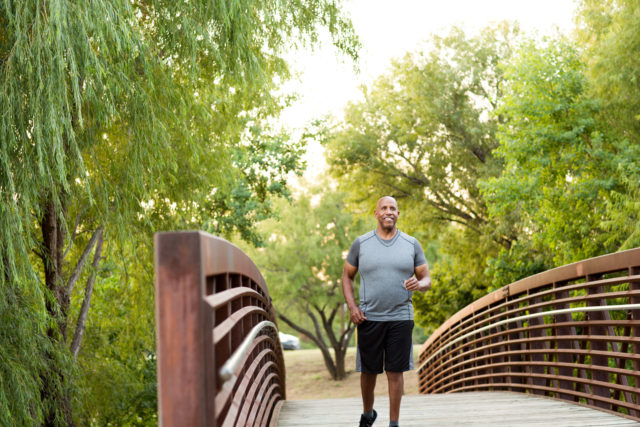
If you don’t already exercise regularly, here are a few steps to get you started.
Physical activity is good for your overall health and can help reduce the risk of many chronic conditions and diseases. But don’t think you have to join a gym or work out for hours a day to get results. Adding even small amounts of moderate activity into your life can go a long way towards improving your health.
“Exercise is also a great way to improve your mental health. It helps to release hormones that improve mood, anxiety, and general well being.” -Joseph A. Larriviere, MD, Internal Medicine
If you’ve been relatively sedentary and don’t know where to begin, start by walking. This low-risk physical activity is the perfect way to ease into exercise. It’s low-cost, can be done almost anywhere and is easily adapted to any fitness level.
In addition to making it easier to lose or maintain weight, walking helps:
- Reduce the risk of serious diseases, such as heart disease, stroke and diabetes
- Lower blood pressure and improve cholesterol levels
- Boost bone health
- Increase energy and stamina
The only thing you need to get started is a good pair of supportive shoes and some comfortable clothes. Then follow these 5 steps and you’ll be on your way to a healthier you:
- Take that first step. Begin with short distances at a pace that feels comfortable to you. Even if you can only walk to the mailbox or around the house, that’s a good place to start. Gradually increase the amount of time or distance you walk by 10-20% each week.
- Skip the all-or-nothing attitude. The American Heart Association recommends adults get 150 minutes or more of exercise weekly. Many people aim to break that up into 30 minute session 5 days a week. Even if you can only fit in a few 10-15 minute walks a day, it all adds up.
- Maintain good form. Find a natural stride that feels comfortable to you and pay attention to your posture. Keep your head lifted and shoulders relaxed. Swing arms naturally.
- Mix it up. As you get more comfortable moving, add some variety to your walk. Add intervals of faster walking with slower recovery periods. Find some hills or hit the trails to cover different terrain to help tone muscles and improve balance.
- Stretch. At the end of your walk, take a few minutes to stretch warmed up muscles to increase your flexibility.
Copyright 2019 © Baldwin Publishing, Inc. All rights reserved.
Health eCooking® is a registered trademark of Baldwin Publishing, Inc. Cook eKitchen™ is a designated trademark of Baldwin Publishing, Inc. Any duplication or distribution of the information contained herein without the express approval of Baldwin Publishing, Inc. is strictly prohibited.
Date Last Reviewed: February 14, 2019
Editorial Review: Andrea Cohen, Editorial Director, Baldwin Publishing, Inc. Contact Editor
Medical Review: Andrew P. Overman, DPT, MS, COMT, CSCS
Learn more about Baldwin Publishing Inc. editorial policy, privacy policy and sponsorship policy.
No information provided by Baldwin Publishing, Inc. in any article is a substitute for medical advice or treatment for any medical condition. Baldwin Publishing, Inc. strongly suggests that you use this information in consultation with your doctor or other health professional. Use or viewing of any Baldwin Publishing, Inc. article signifies your understanding and agreement to the disclaimer and acceptance of these terms of use.